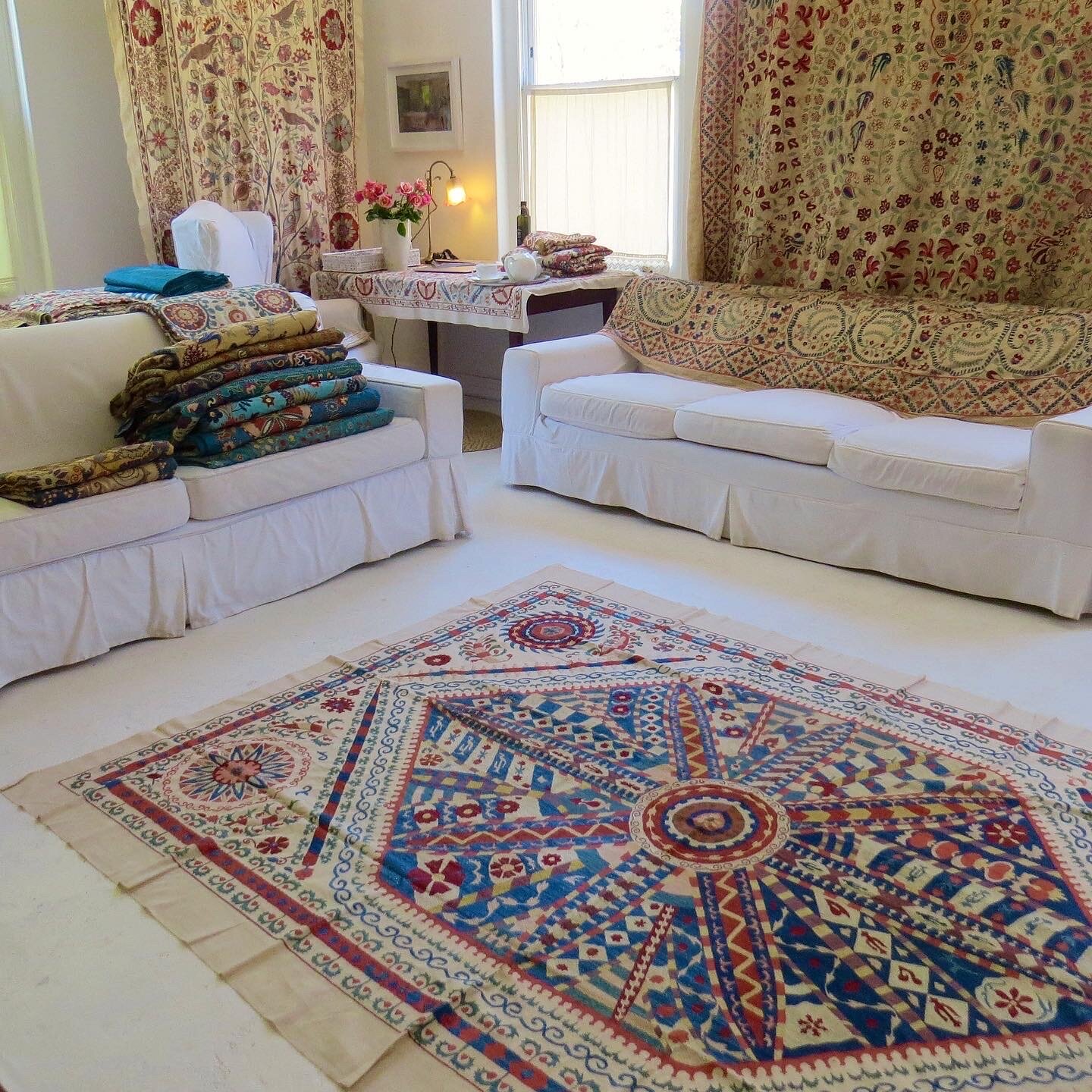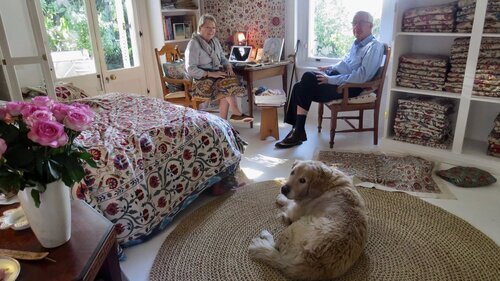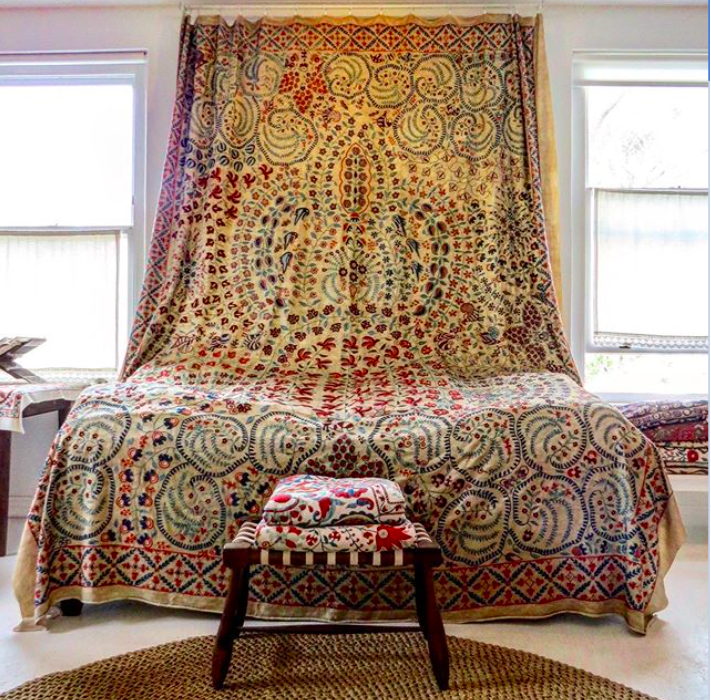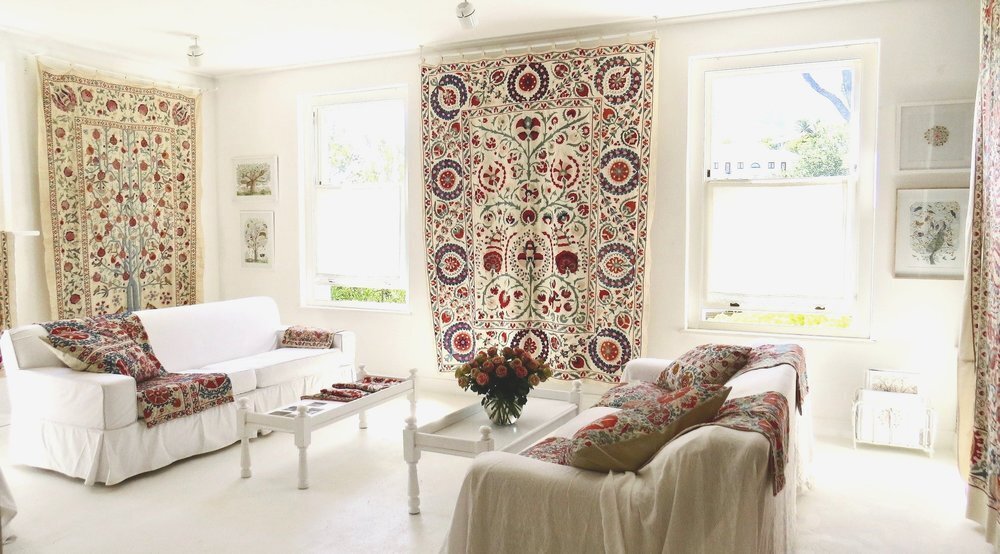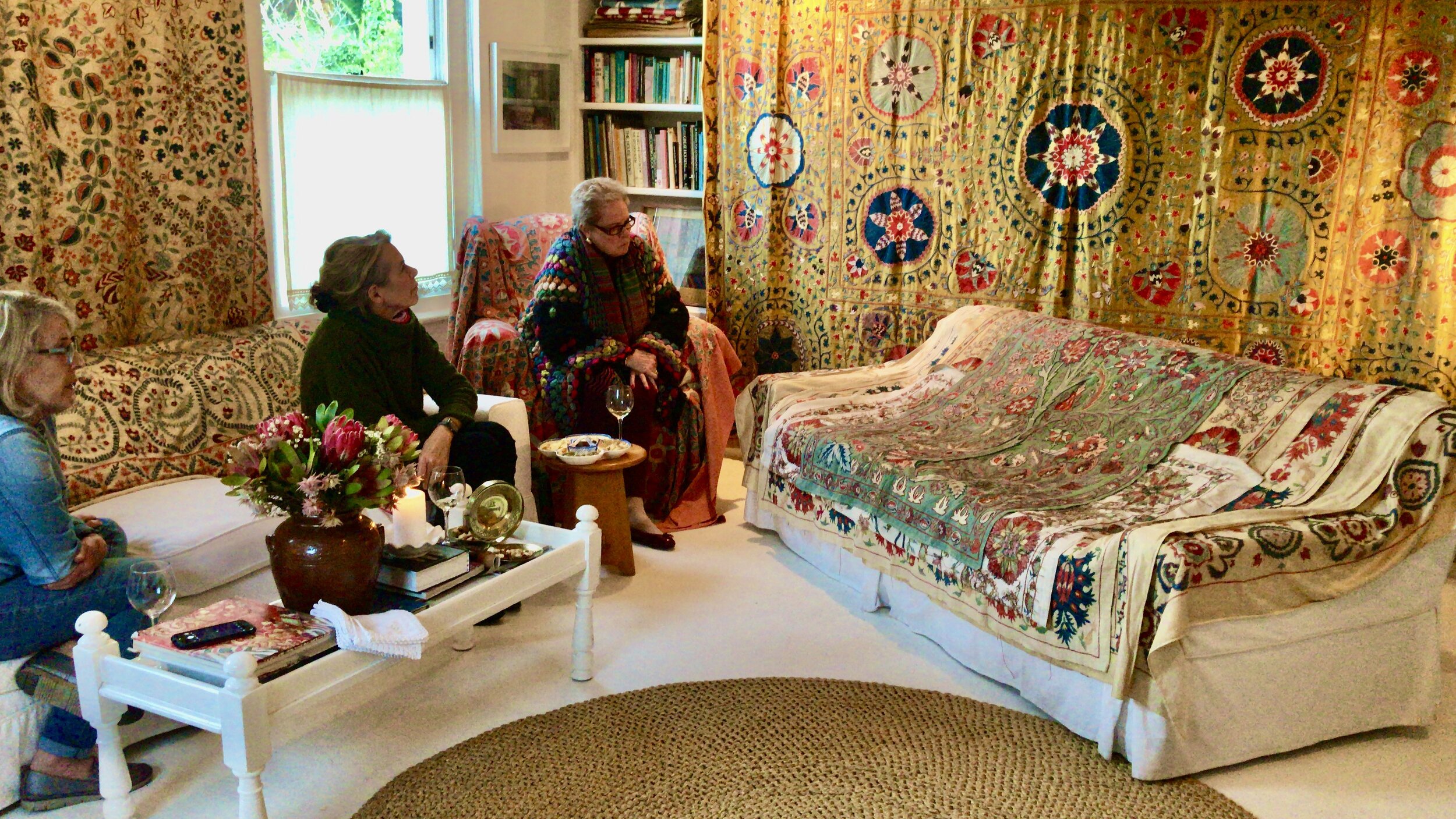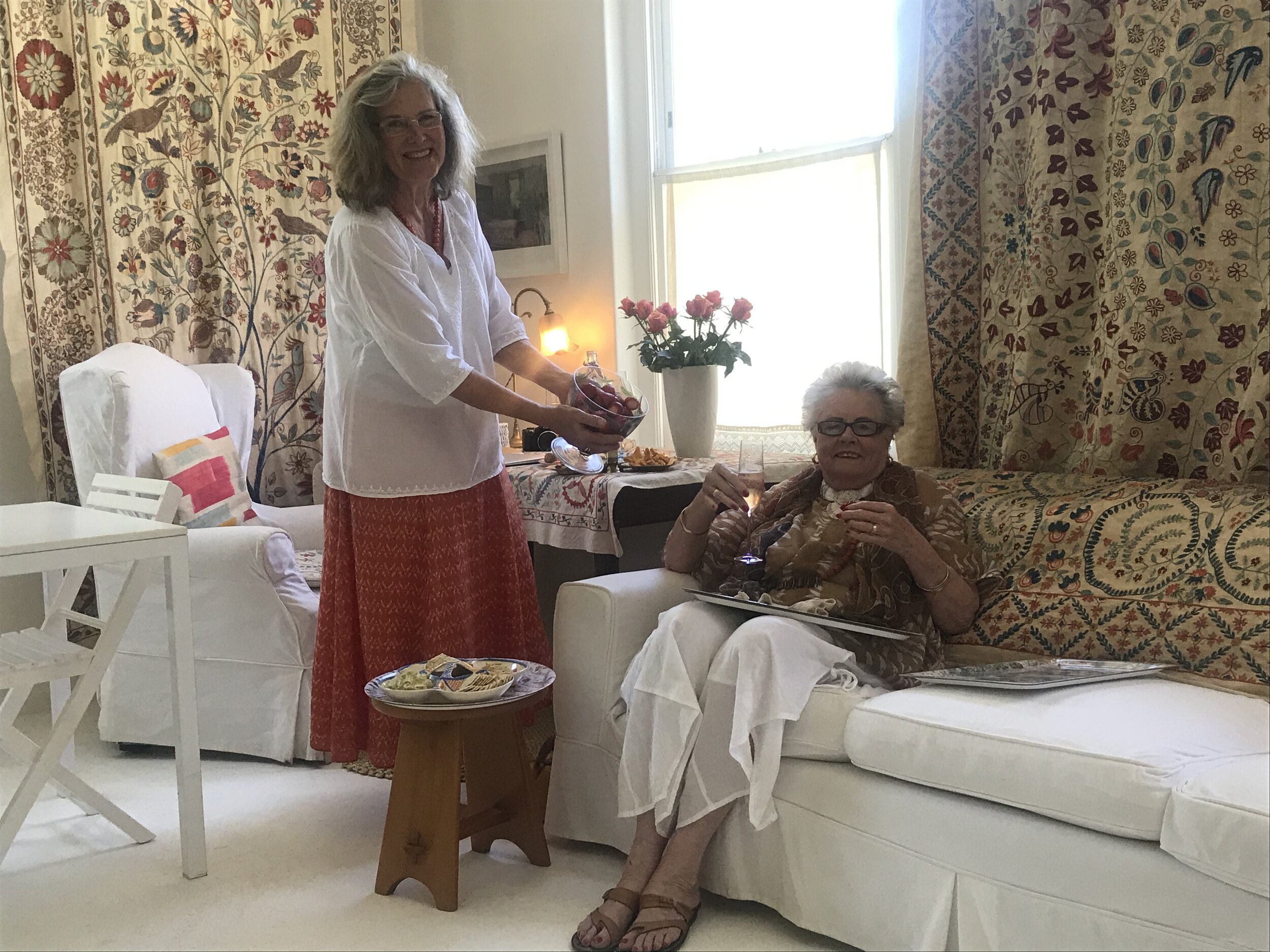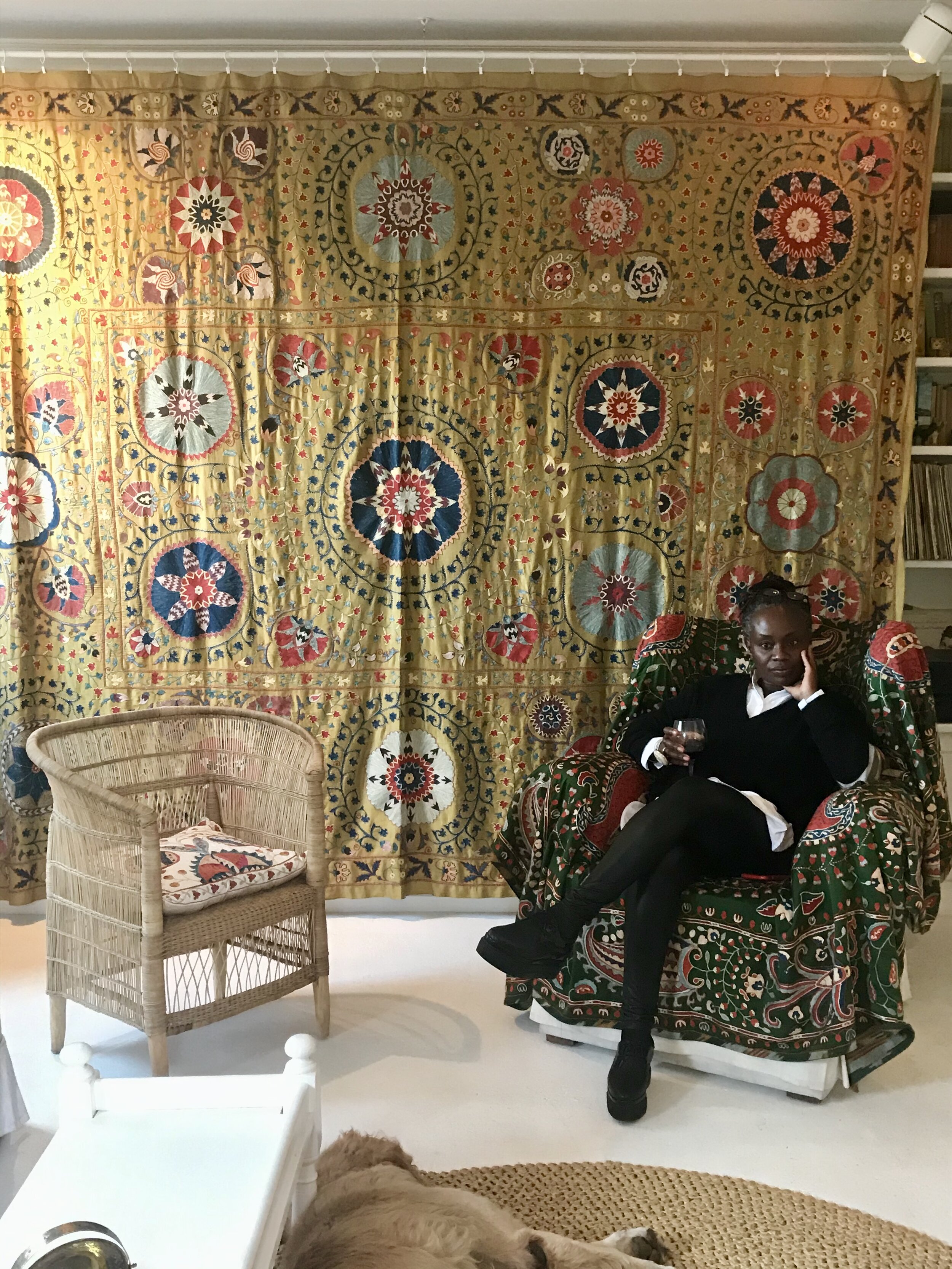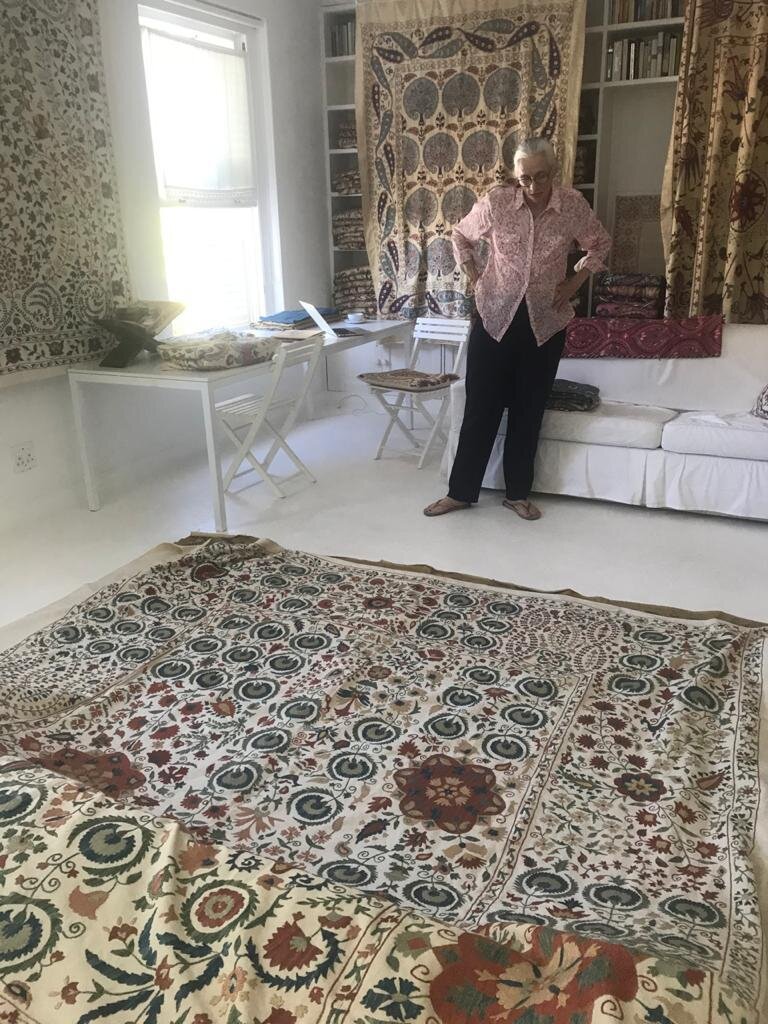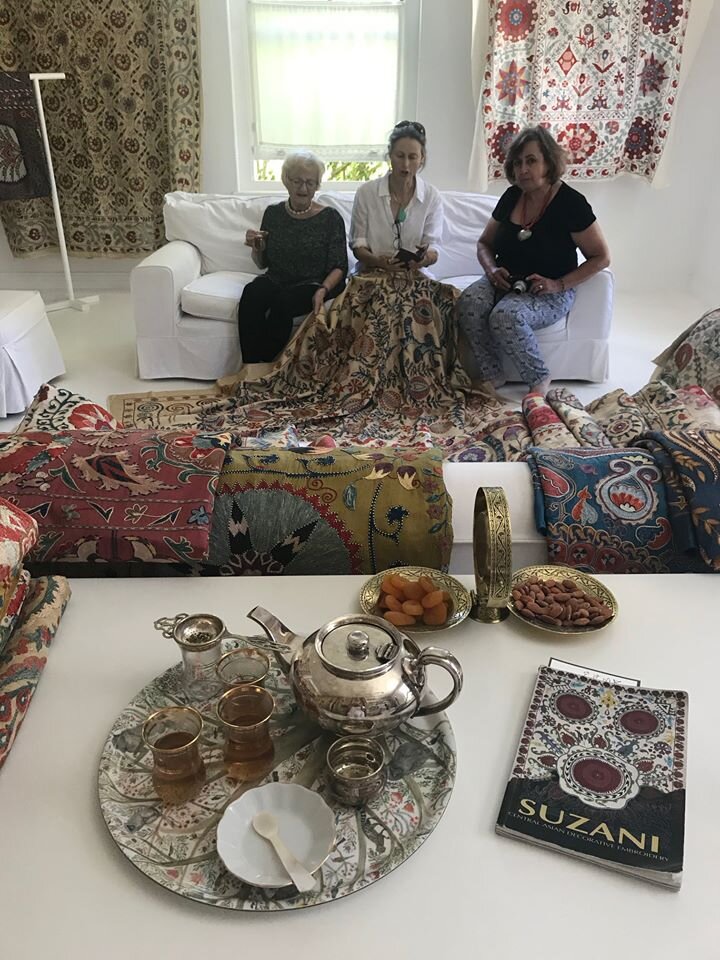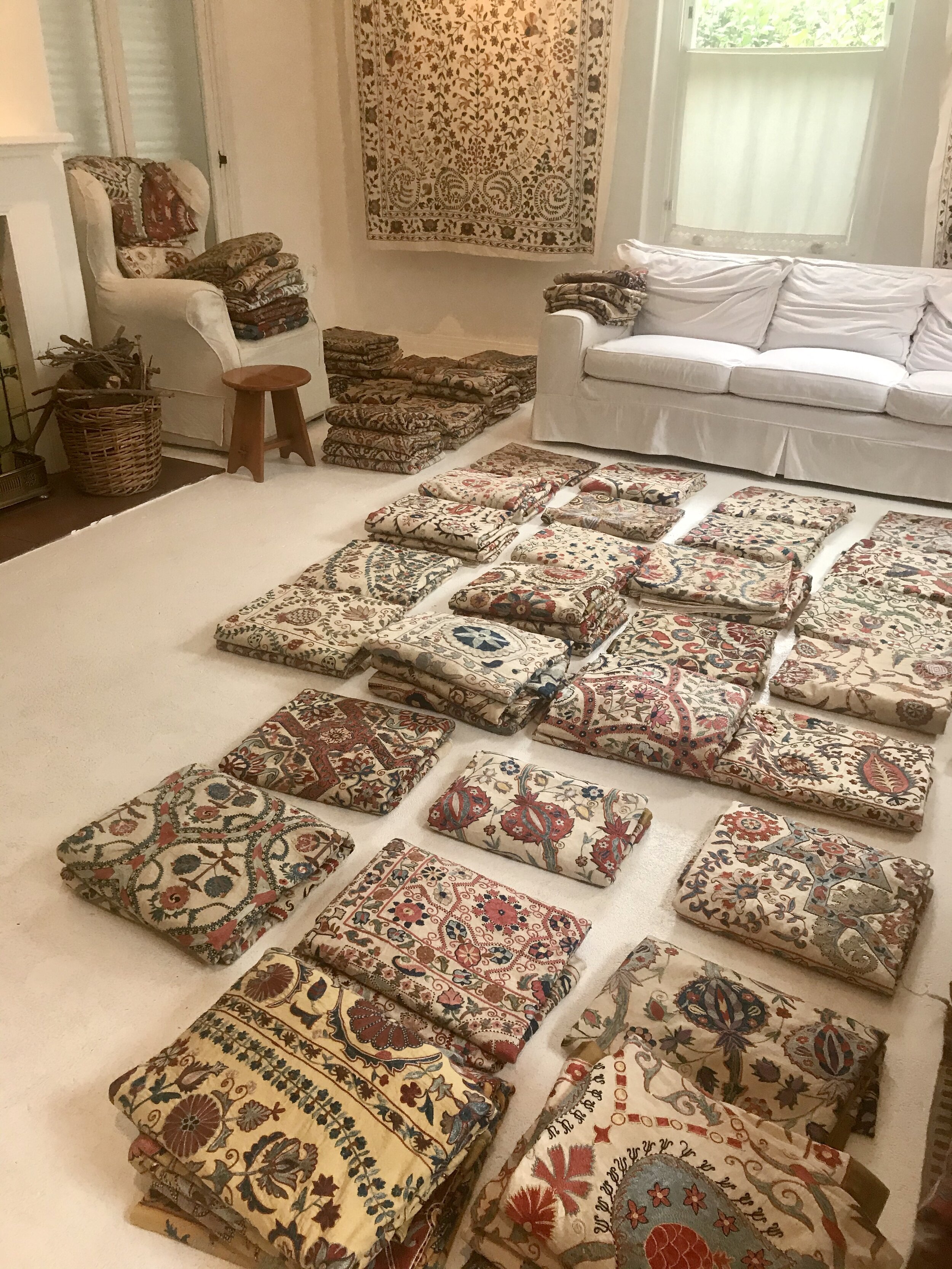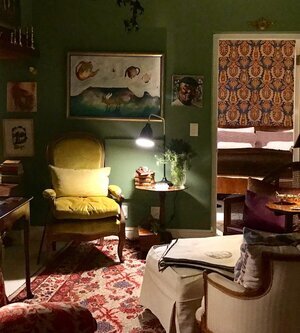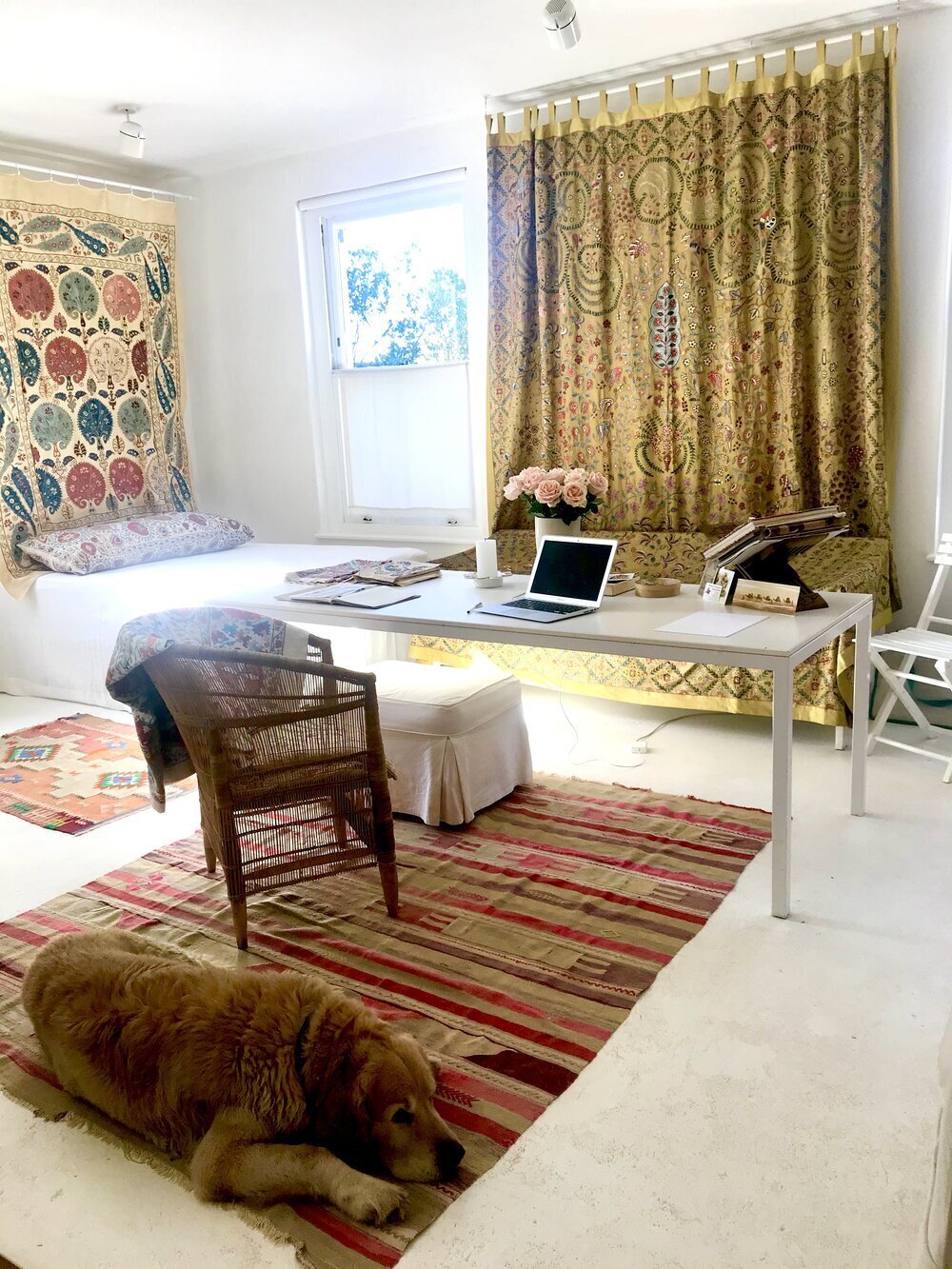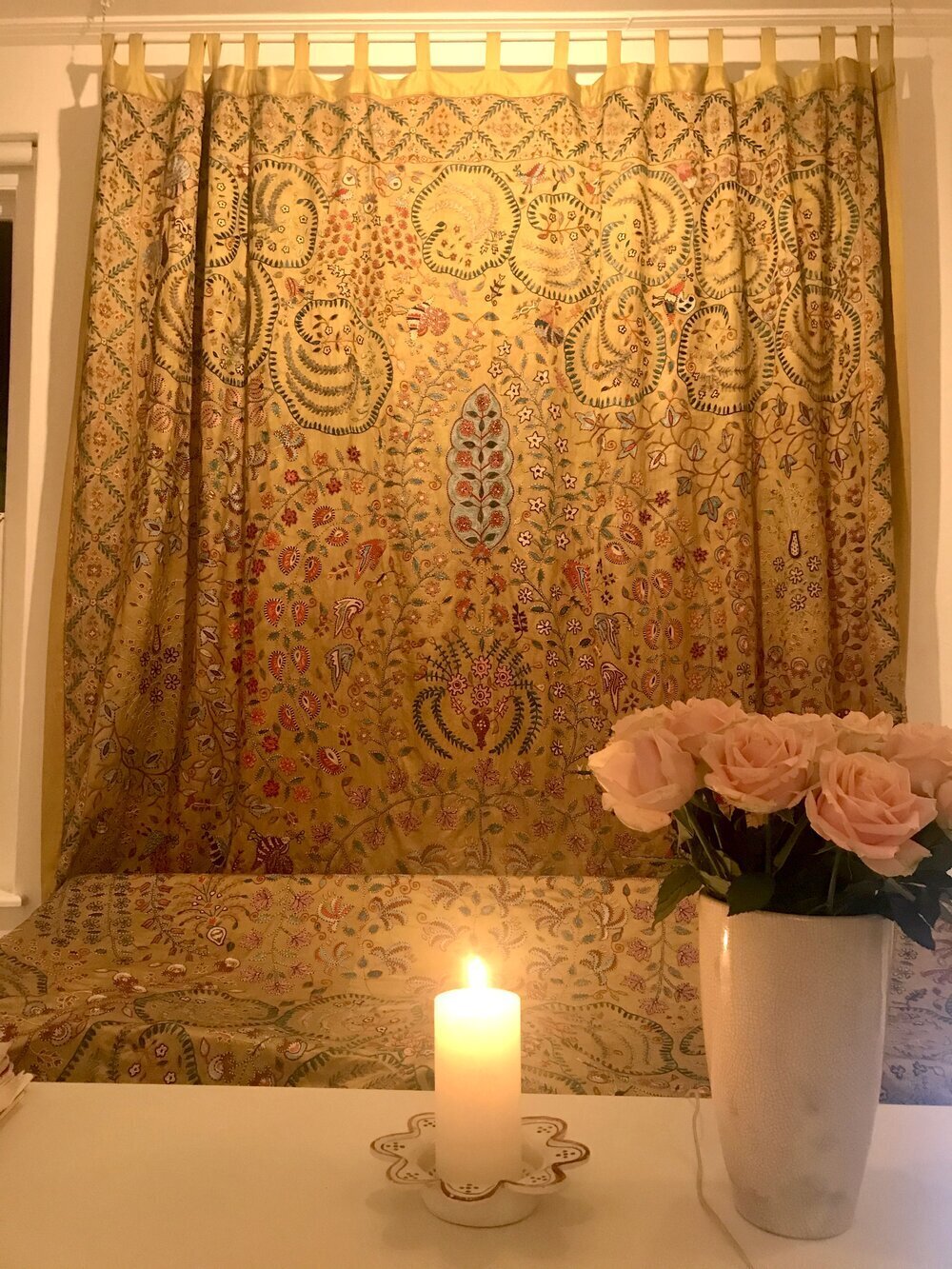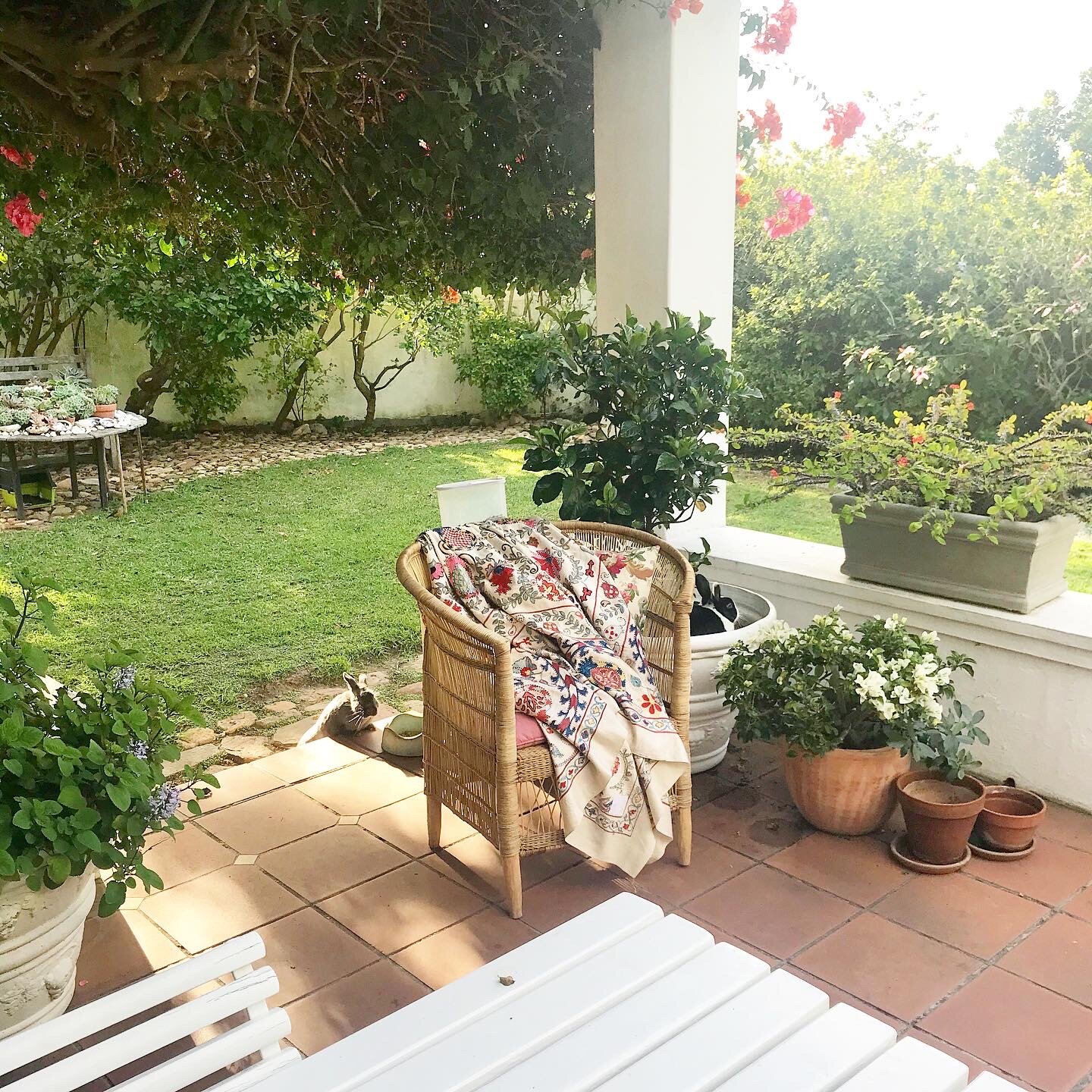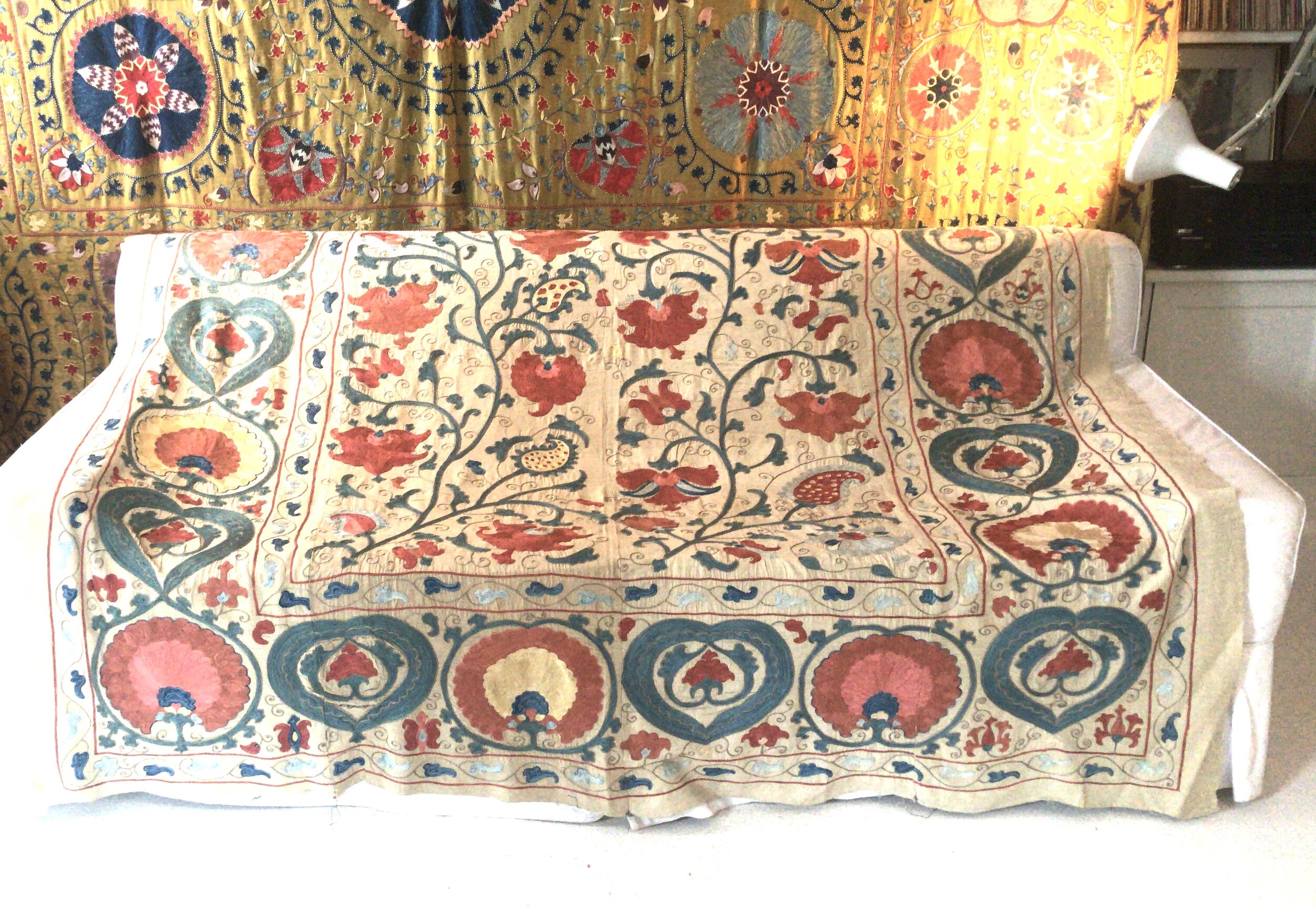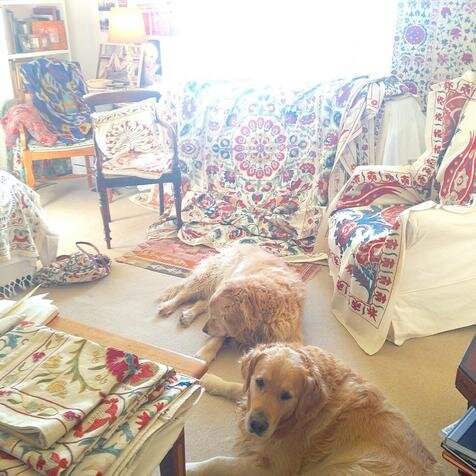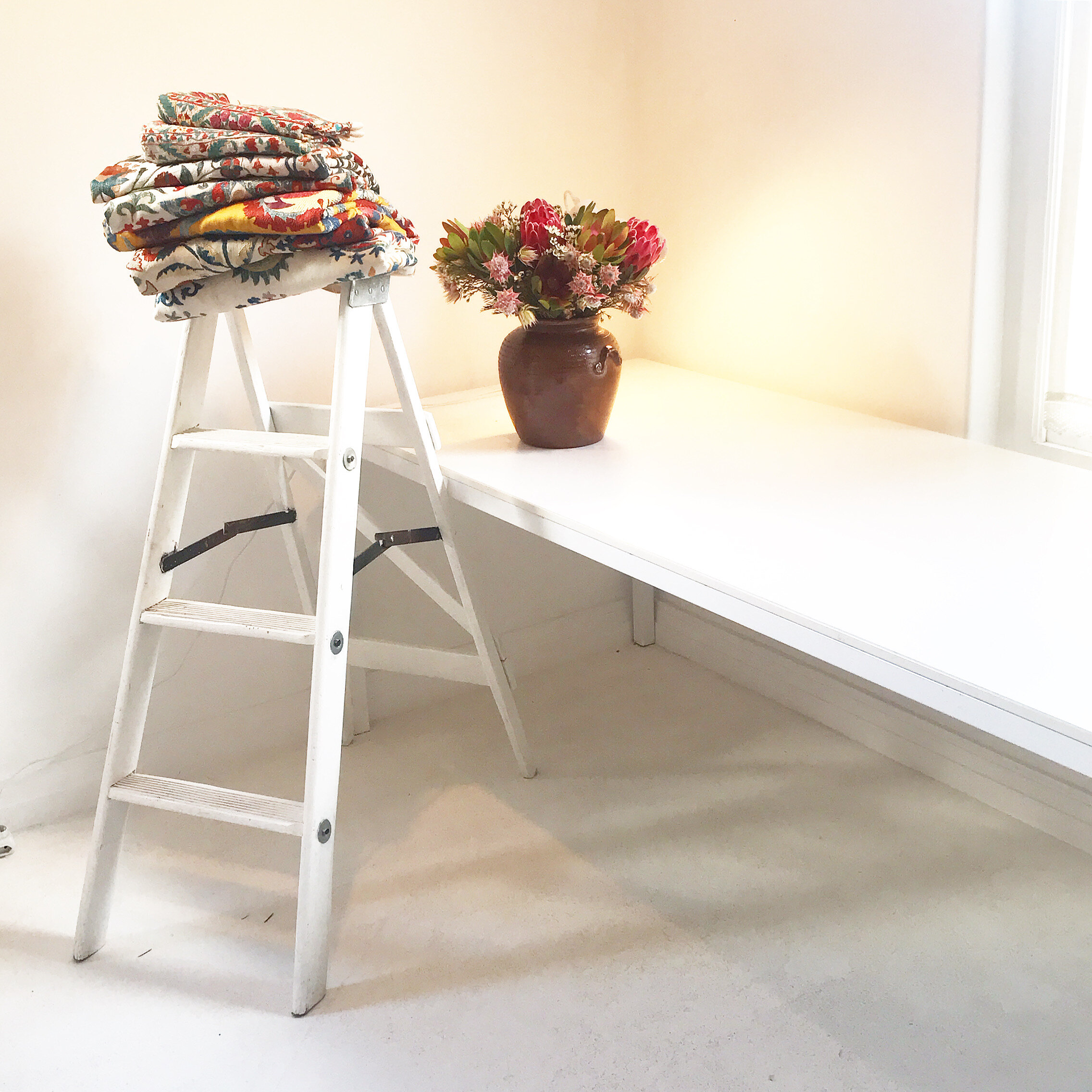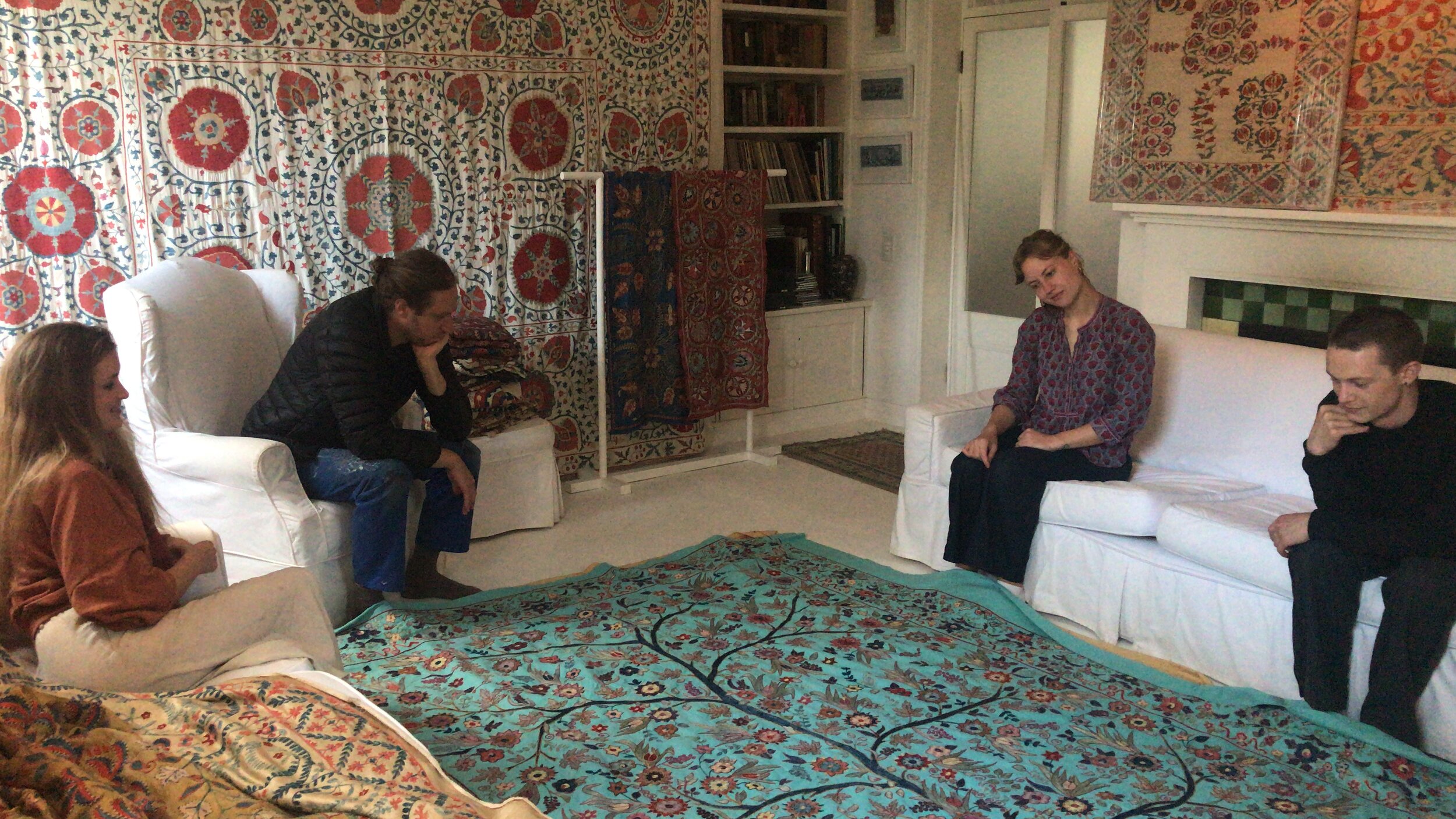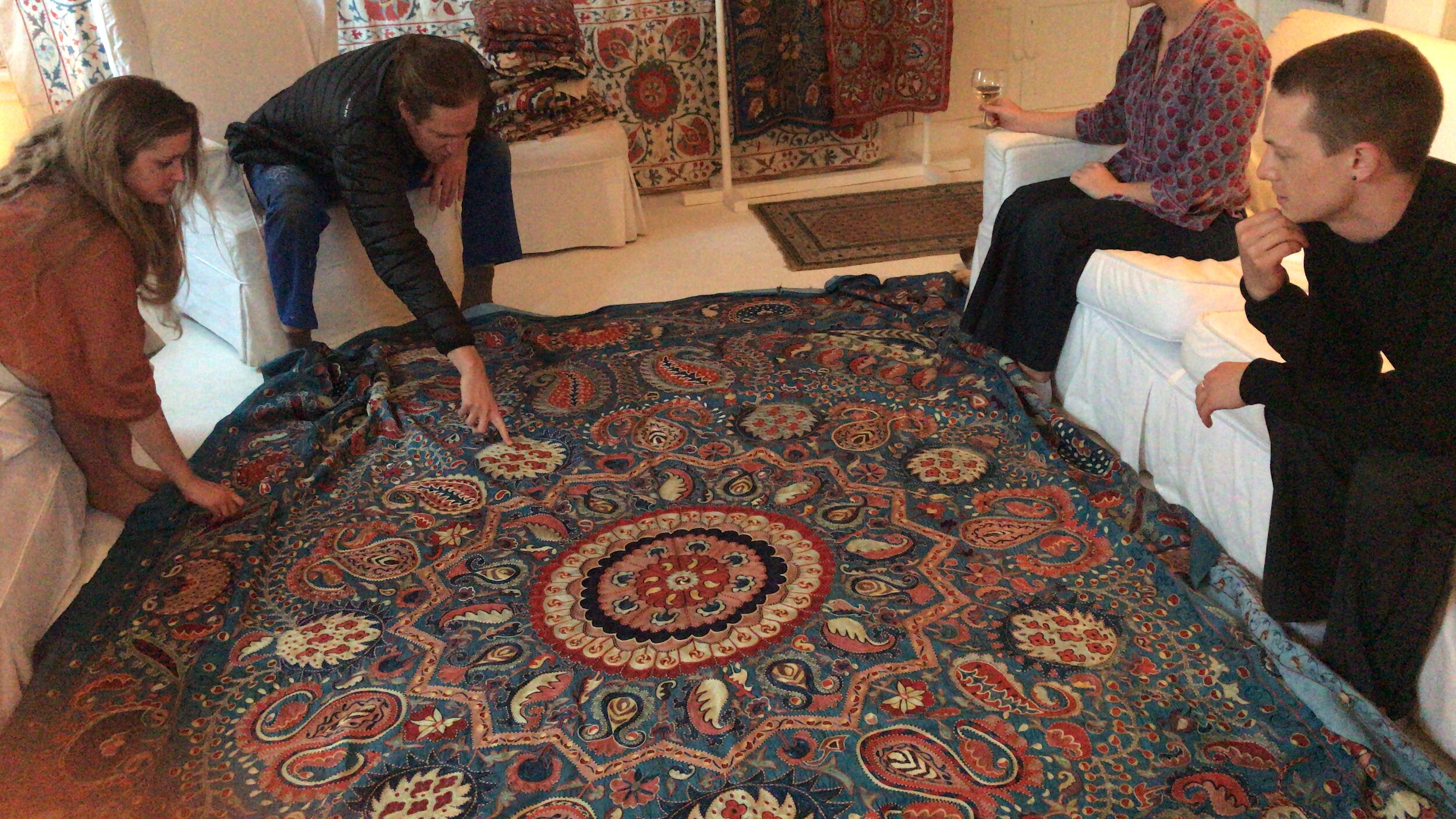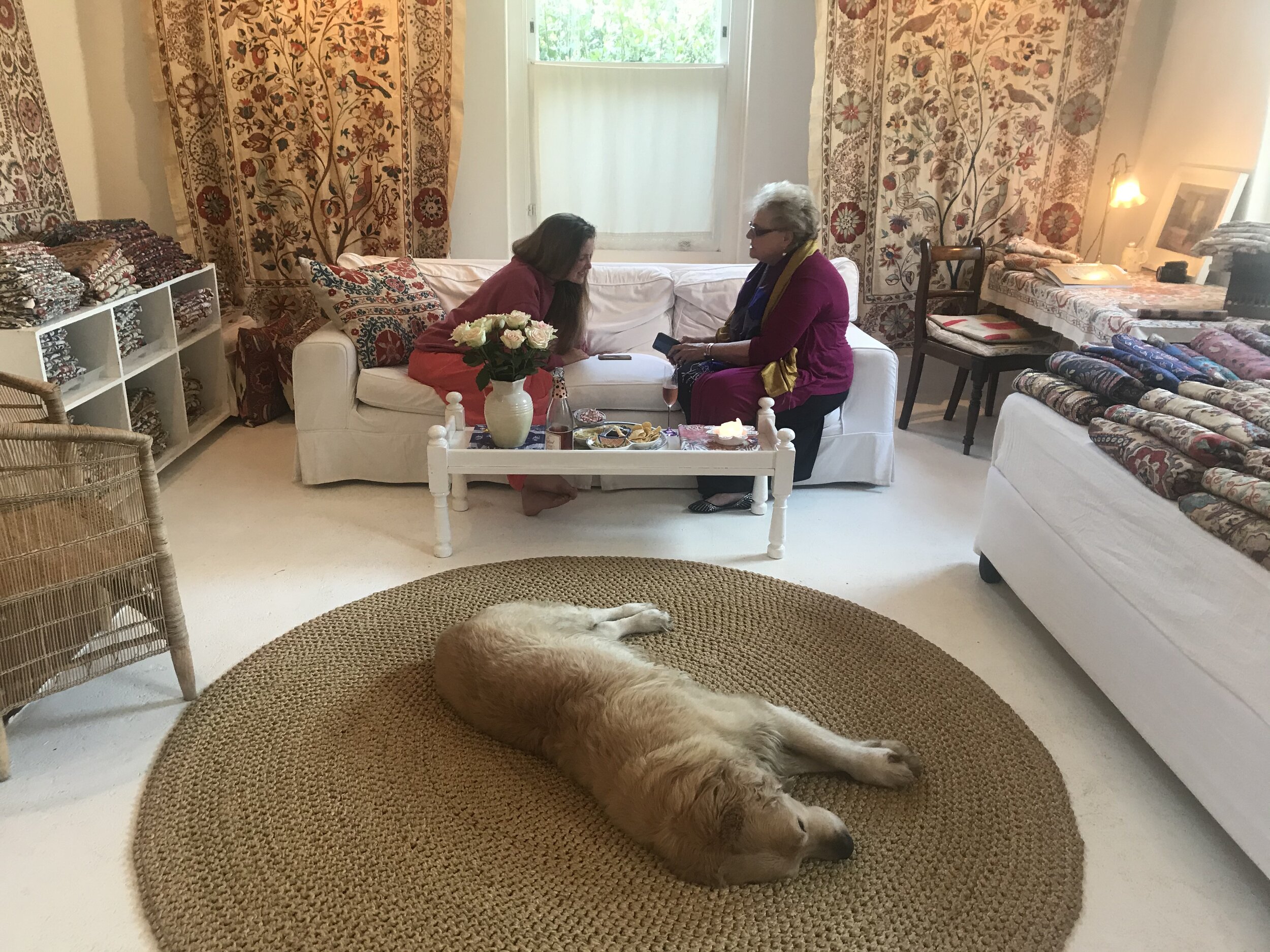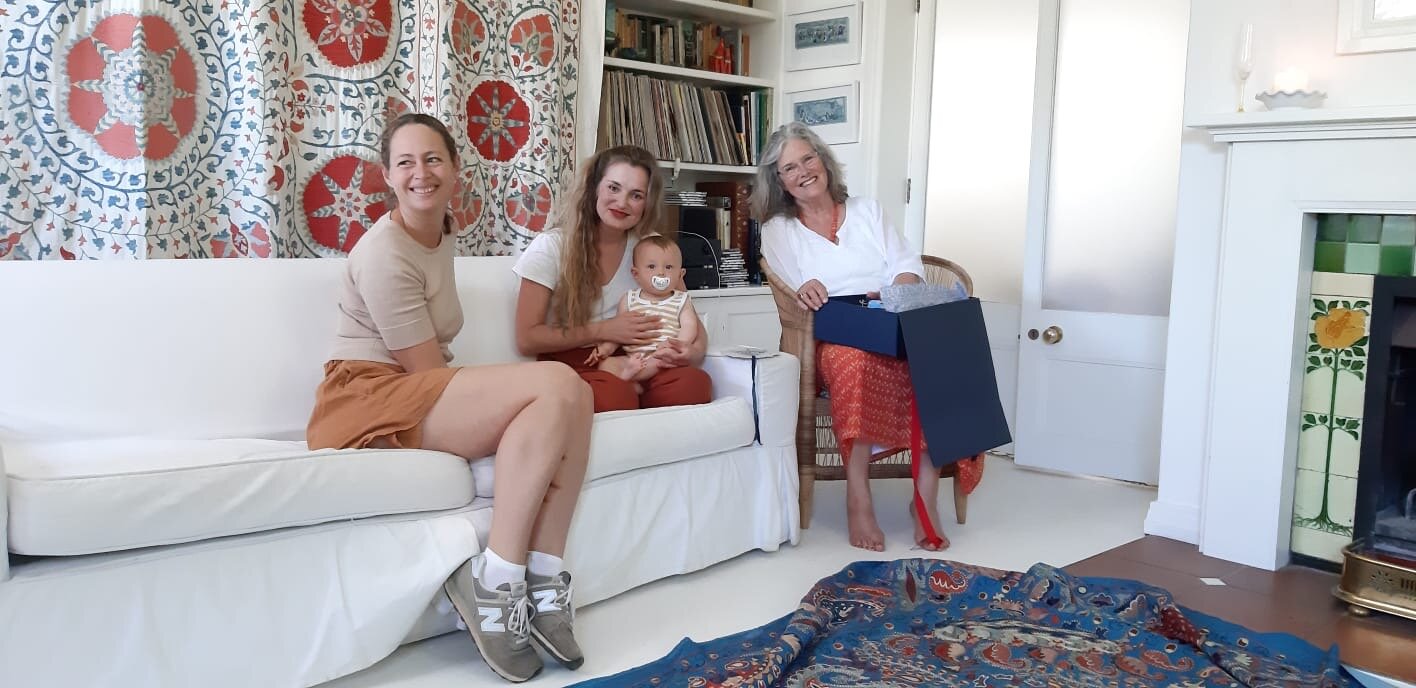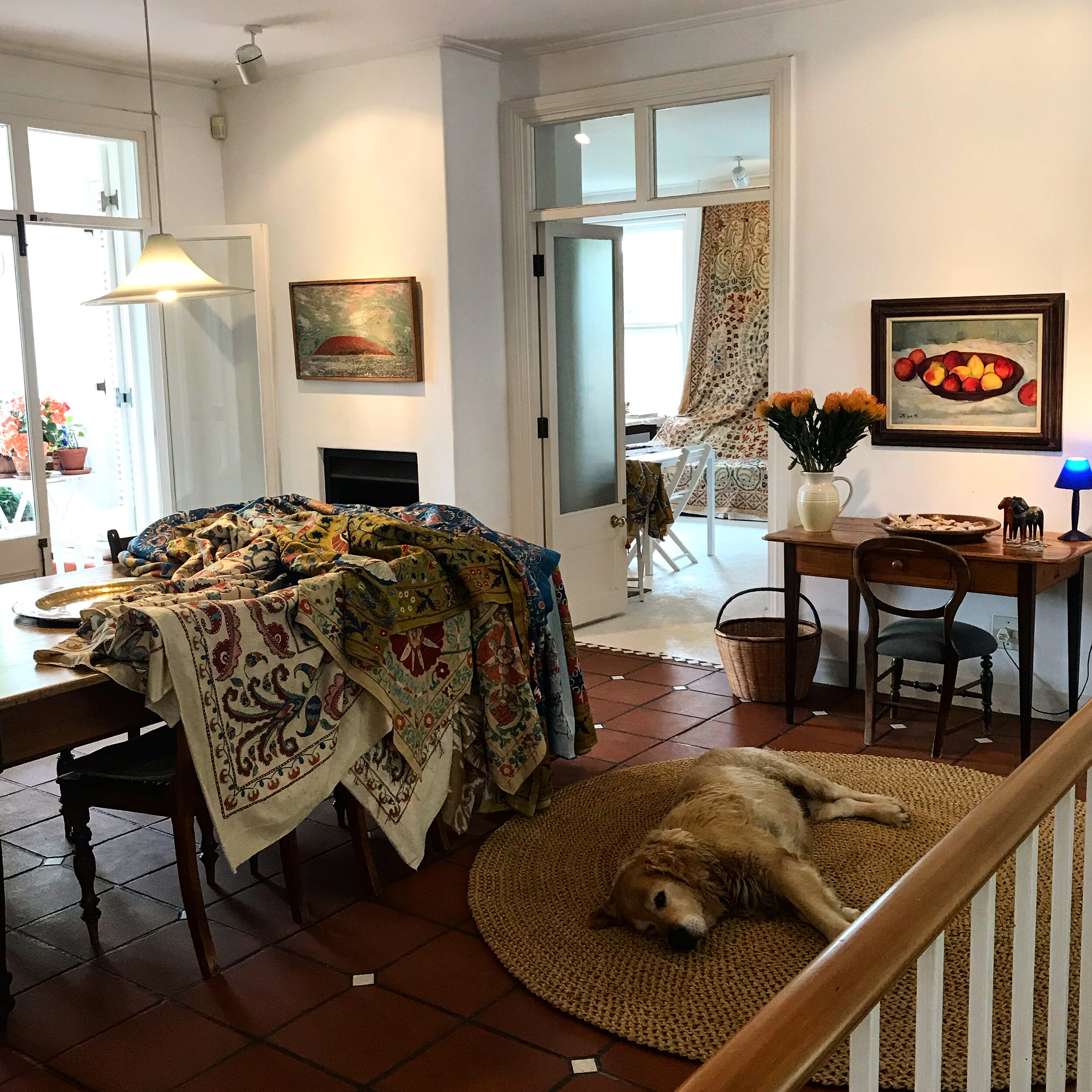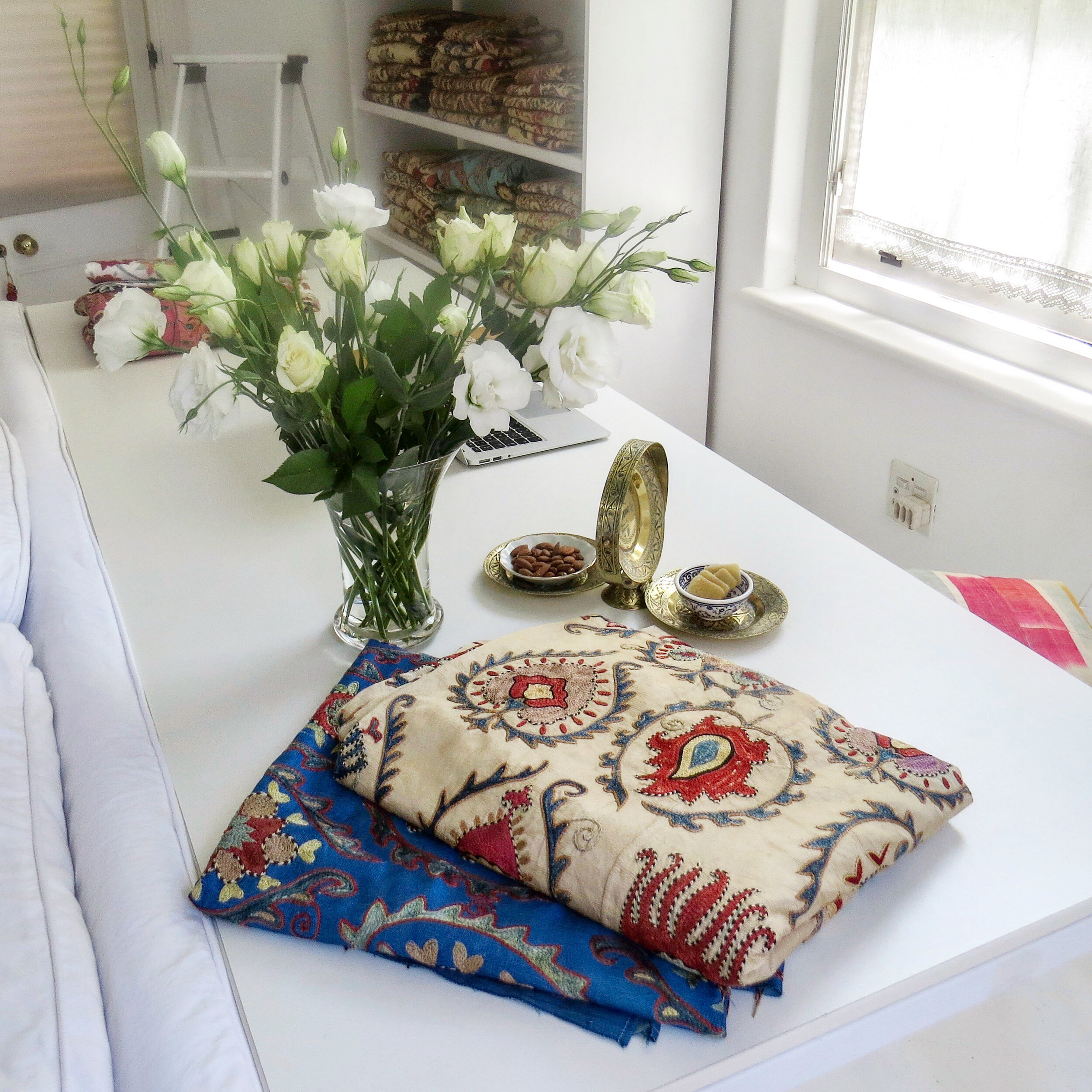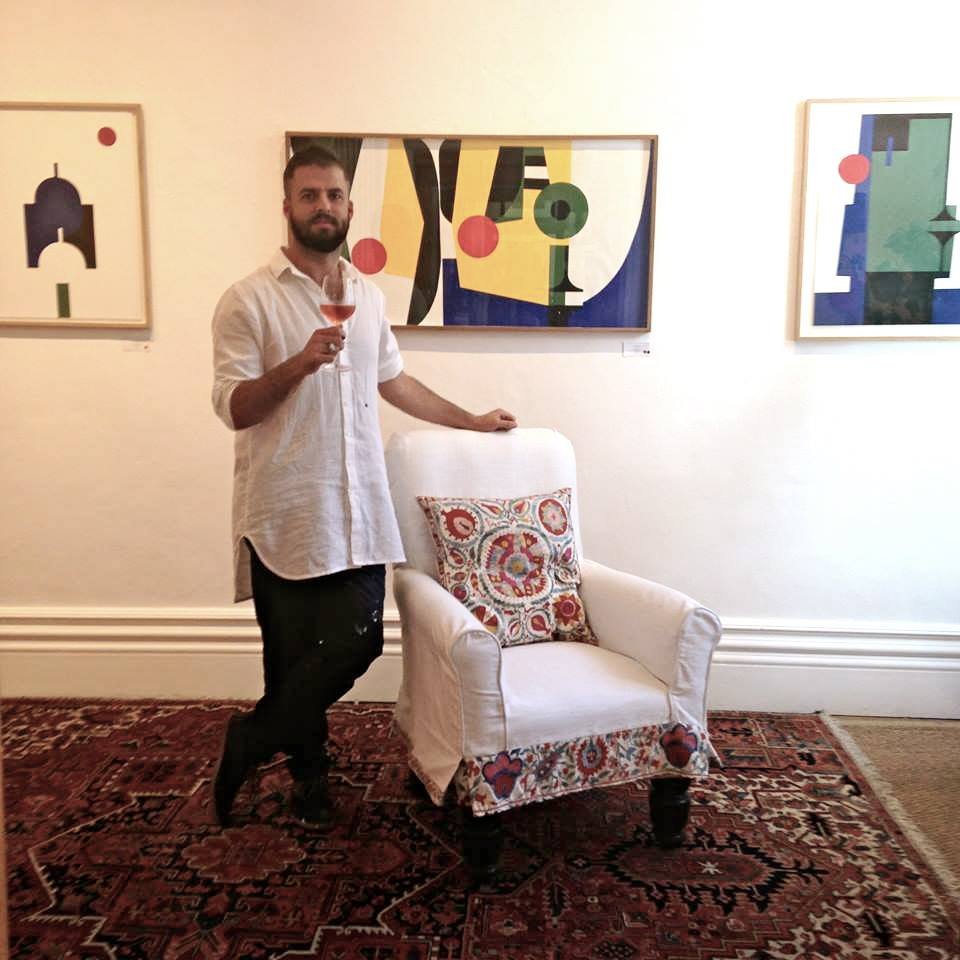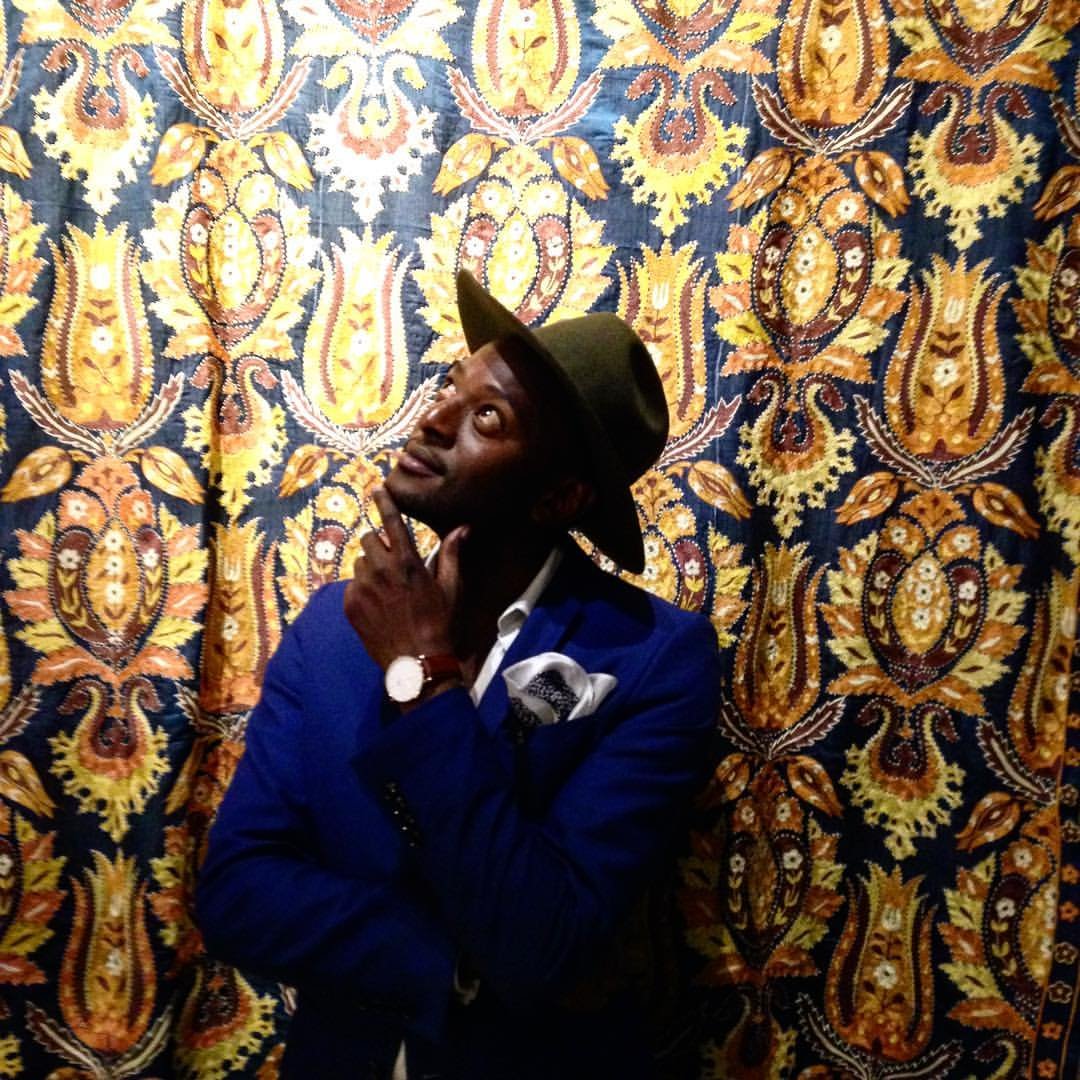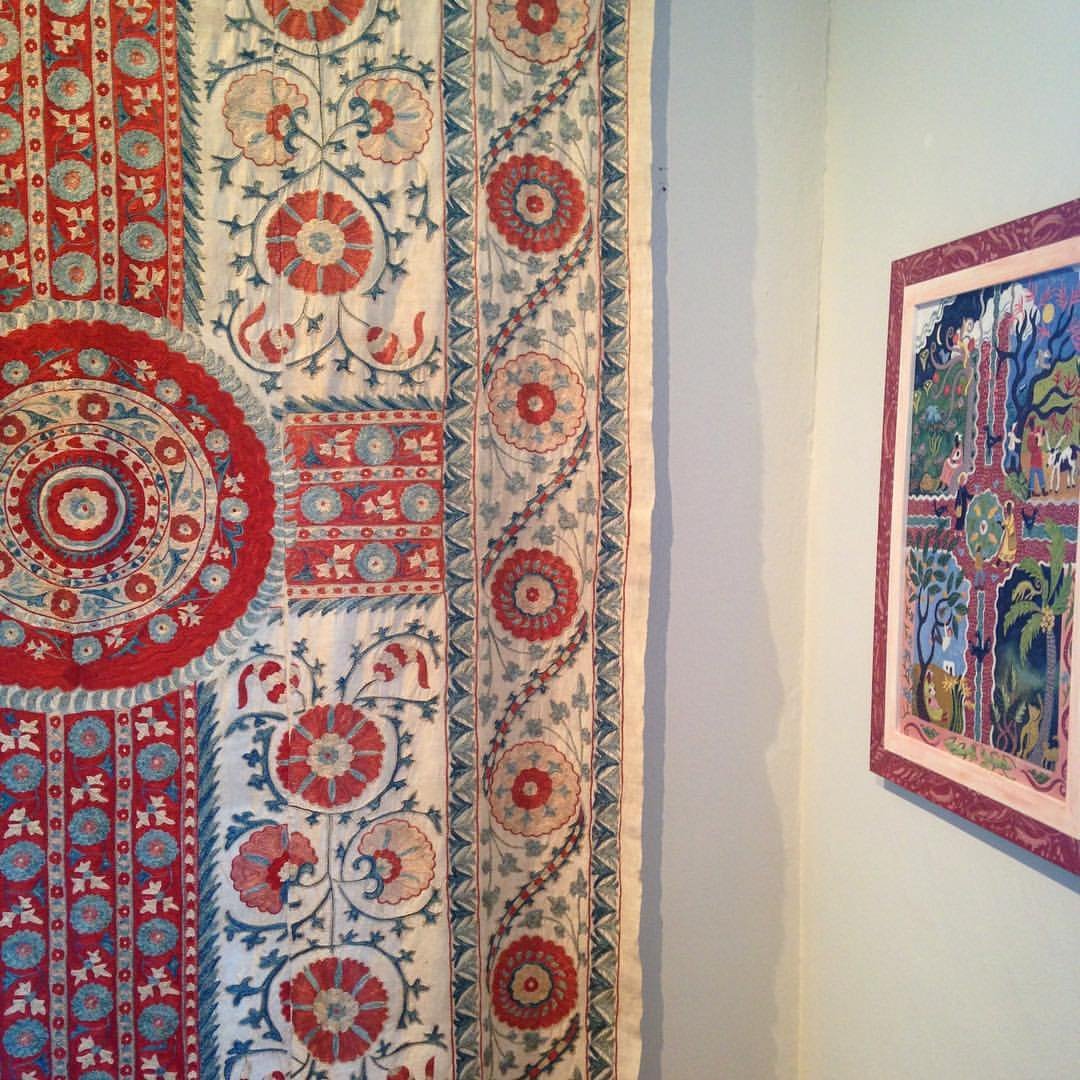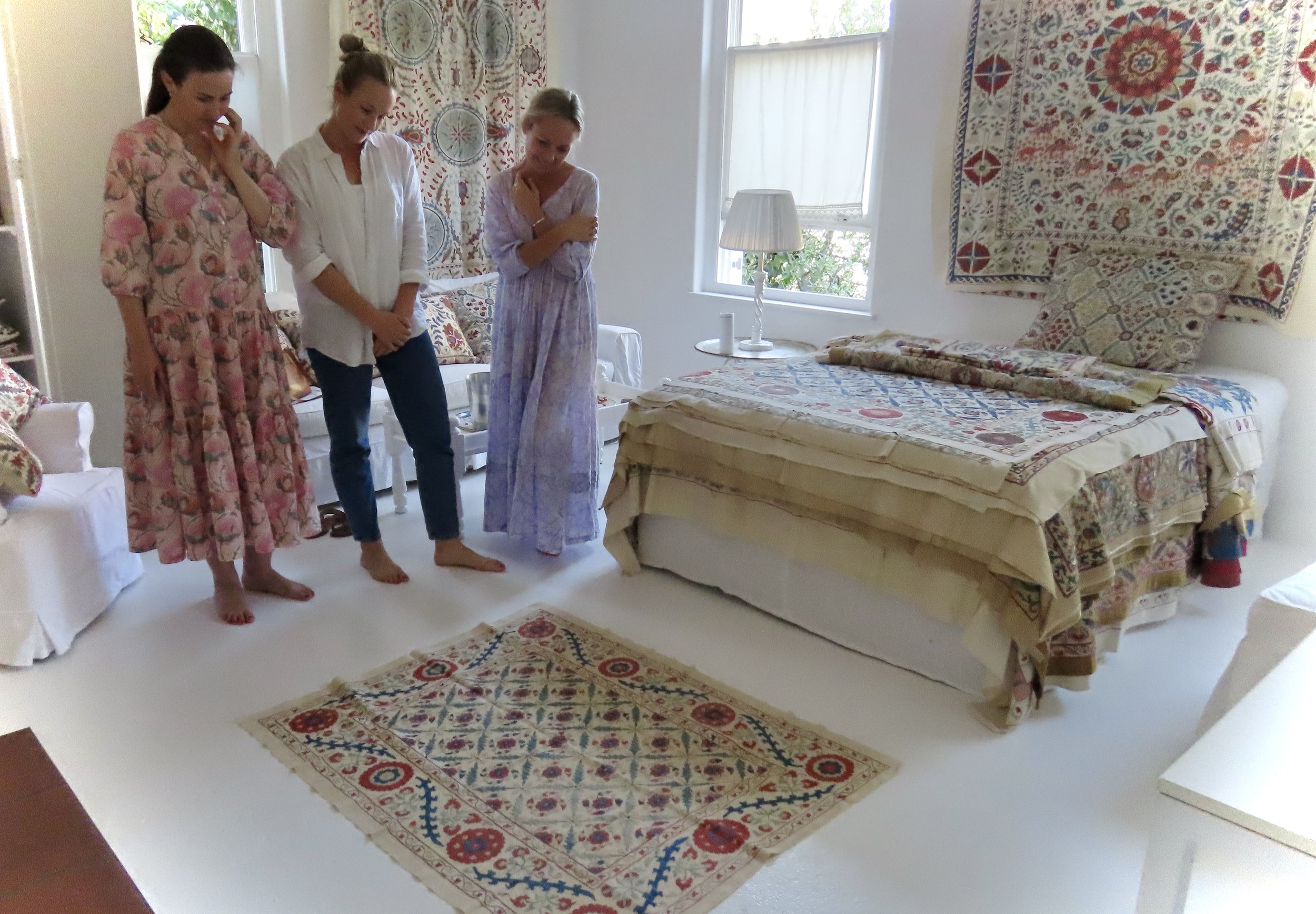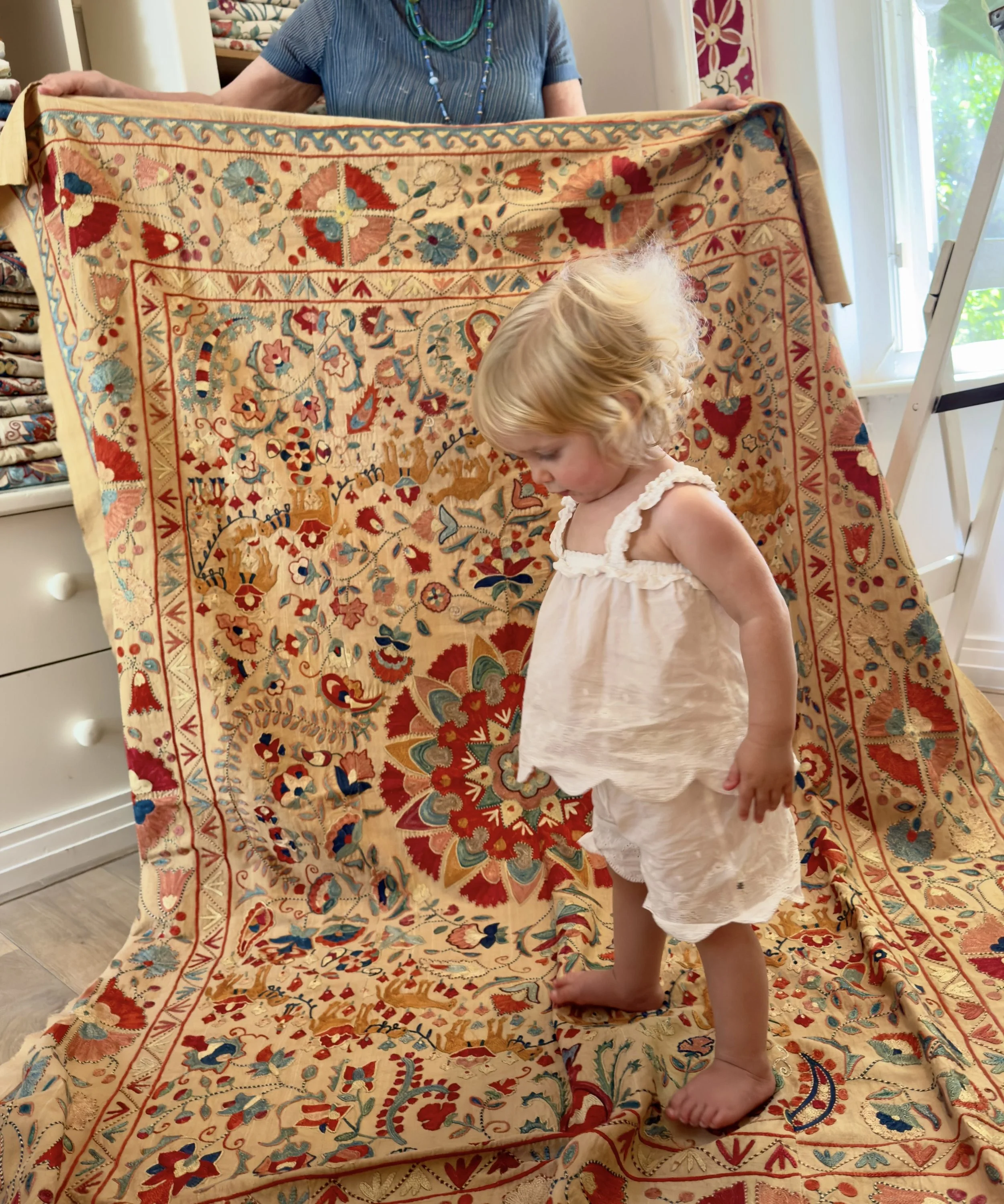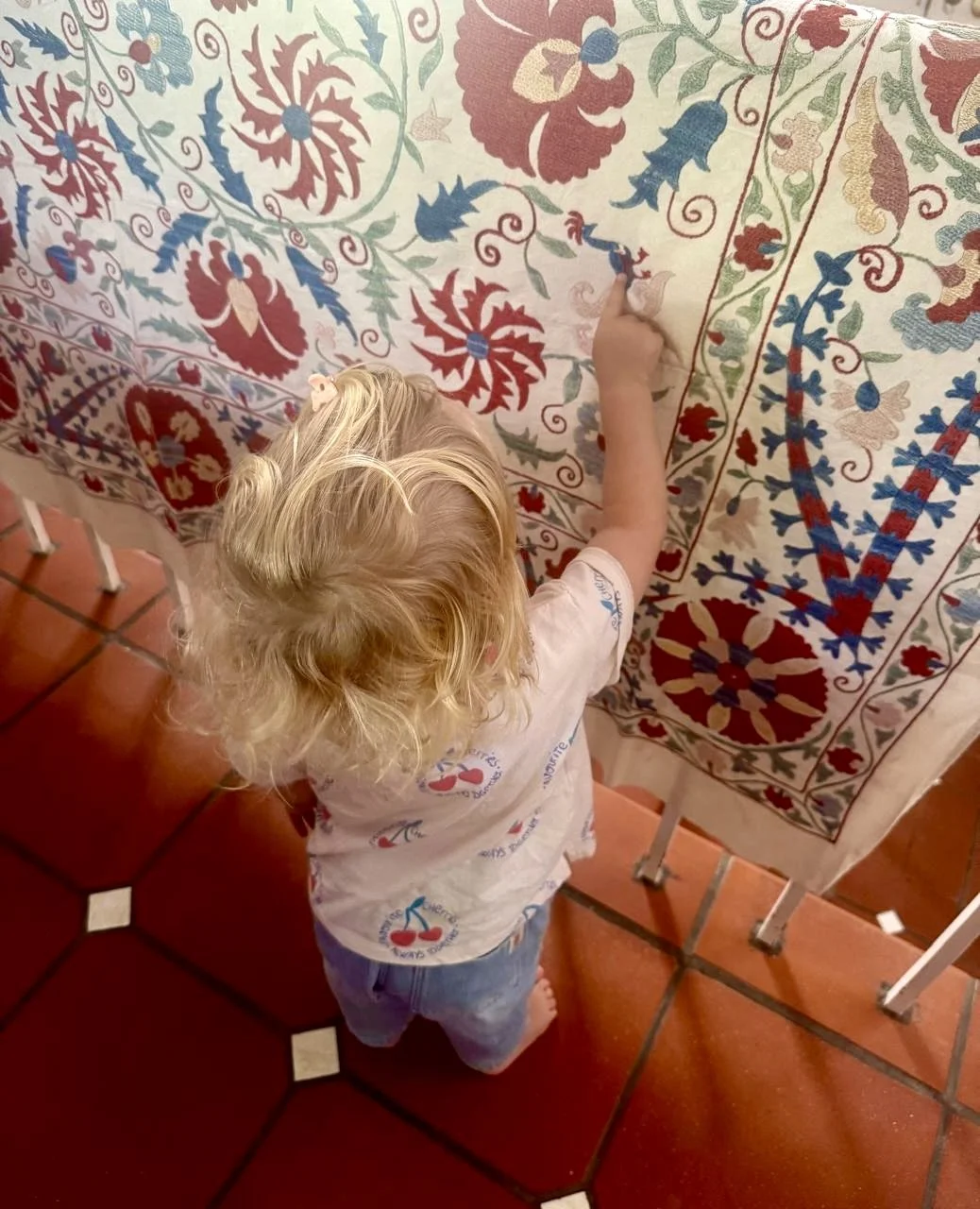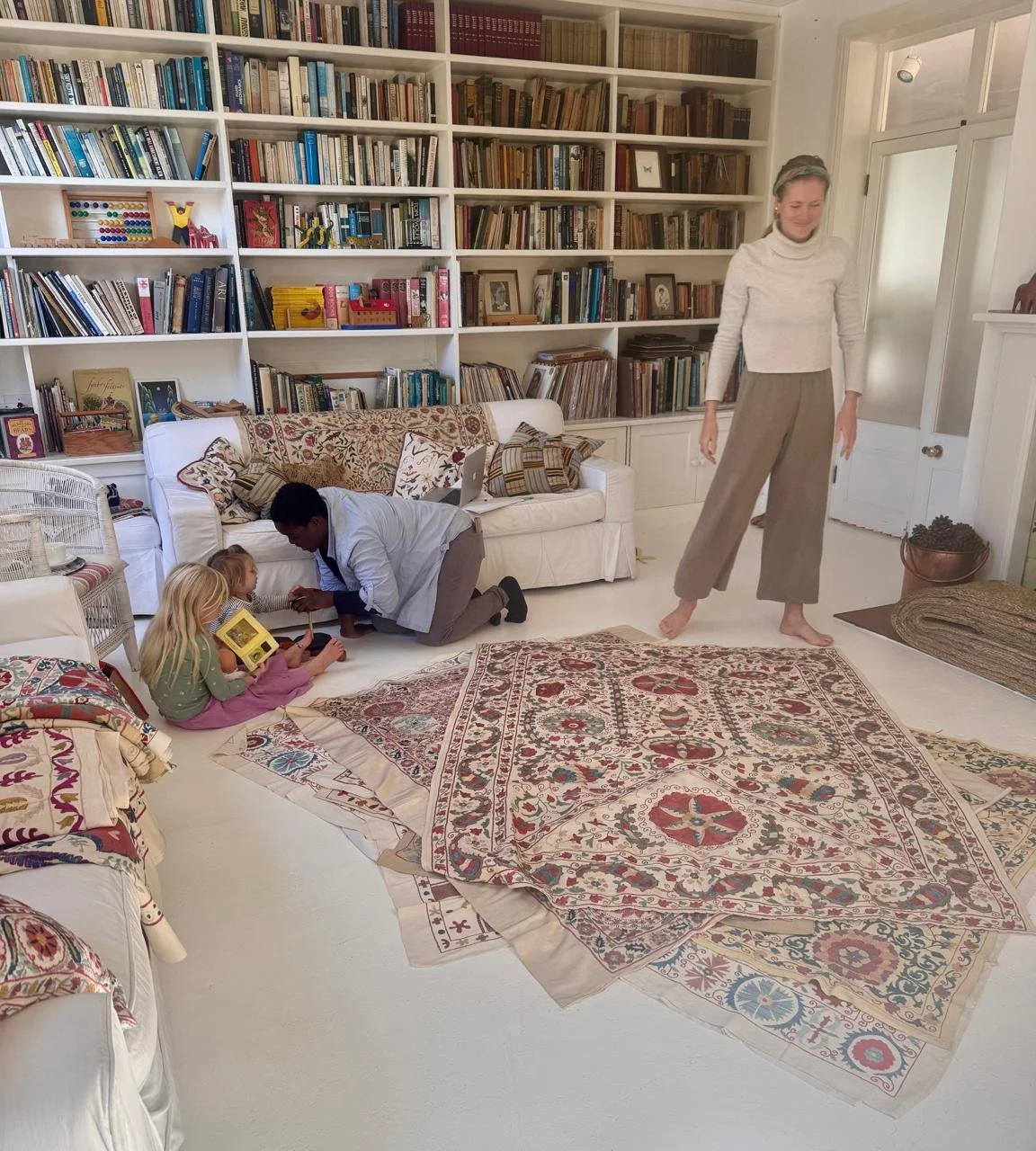"Suzani embroidery has withstood the passage of time. Each authentic Suzani tells a quiet story to those who understand. Her language is one of motifs and colour that speaks magical messages that have grown and has been transformed over generations, but still continue to express the same feeling.”
( author unknown )
“Each Suzani embroidery is unique. Our Suzanis are the antique art of tomorrow. They are the antiquity of the future: pure timelessnesses”
( Azizbek Gulyamov )
“Textiles are the architecture of an interior, they bring passion to a space. They are an immediate window into the soul of the home owner offering a glimpse of their taste and personality. They create comfort, warmth, presence and individuality to a space unlike any other interior design instrument.”
( Interior designer / Martyn Lawrence Bullard )
The Suzanis in our collection were produced by a man who is proud of his heritage and the beauty of traditional Suzanis, and strives to preserve traditional and authentic silk hand-embroidered Bukharian Suzanis. He is a facilitator of contemporary interpretations of Suzanis that remain true to their ancient origins in terms of design and production. He grew up during the Soviet era.
He says, “It is important to preserve history as you cannot have a future without knowing your past. These Suzanis represent to me an anthem to human and cultural identity, assuring that nothing has been lost. People have tried to take our history, but we are reclaiming it.” History has shown that suppressing a community's identity only creates a bigger thirst for its visual expressions of its past.
Azizbek and his own carefully selected team were responsible for creating their own unique rebirth of Suzani creation based on interpreting traditional museum, and private collection Suzani examples, since Uzbekistan’s Independence from Soviet Rule during the early 1990’s until the last work was commissioned in 2020. A very large body of work of which I became involved in since 2012
Each Suzani was produced using age old traditional customs and was embroidered in pure Bukhara silk from mulberry fed silkworms. Each Suzani was embroidered by strictly one woman artist alone to ensure consistency in the stitching and also to embed the spirit of its creator in her work to ensure creating a true work of art to share with the world
My task has been to look after the Suzanis in my care in Cape Town, to tell their story and to find homes for each one worldwide
If you are thinking of acquiring a Suzani from us
Please save images from my Instagram account or website and share them with me to give me an idea which Suzanis to get ready to share with you and show you directly
It is a great help if you share images of the room where you are thinking of placing a Suzani and more or less the size you have in mind.
We do not share a catalogue
( for copyright reasons )
I am in the process of posting all our Suzanis on instagram to make it easier for clients to choose the kind of Suzani they might love best.
i share more detailed images and prices with clients privately online
I can be reached on WhatsApp, Instagram
Suzani ± Sizes
Small Suzanis are from 110 x 90cm to 150 x 100 cm in size
Medium Size Suzanis are from ± 185 x 154 cm to 240 x 156cm in size
Large Suzanis can be anything bigger and up to as big as 320 x 280 cm in size
Suzani prices range from ± 700 USD for the smallest Adras Suzani
up to 7000+ USD and more for the largest All Silk Suzanis
Payments for Suzanis should please be made
directly to Bukhara
we use DHL to deliver to anywhere worldwide
The first two photos here were taken by Frances Marais
for House and Leisure Magazine SA
and were published in the House&Garden UK Magazine December till February 2020/2021
they were then published in the September 2022 issue of House and Leisure SA
called BLOOM
The Suzani Room, with mostly my Private Collection
" When you buy something from an artist you're buying more than an object. You're buying hundreds of hours of errors and experimentation. You're buying years of frustration and moments of pure joy. You're not buying just one thing, you are buying a piece of a heart. a piece of a soul… a small piece of someone's life. "
THE UNIQUE AND LONG PROCESS OF PRODUCING SUZANI ART
Understanding the true value of a Suzani embroidery. The creation process is as intricate as the art itself.
The production of a genuine Suzani is an extensive journey that begins long before the embroidering can even start, making each piece a labor of love and a testament to a rich cultural heritage. It is always very difficult to know how long a particular Suzani took to create and complex to explain to clients why a true Suzani is so expensive. Each Suzanis is a unique process in herself and each artist works in her own time available to her lifestyle to create her work of art.
I have summarised here some of the steps in the process that goes into the creation of any true Suzanis
The planning starts very long before the embroidery does.
The first step in the creation is the patron who funds and commissions the process and chooses the concept and design of the future Suzani In our collection. We take pride in interpreting traditional museum pieces and antique Silk Road designs for our collection. We use only high quality silk threads, spun from silkworms nurtured on Mulberry leaves grown on Bukhara trees.
These threads are then masterfully and professionally dyed using age-old techniques passed down through generations, by masters who have studied the secrets and alchemy of dyeing methods using local natural dyes, except for the colour indigo, which we source from India.
The Foundation Fabric
The base cloth, is essential for the authenticity of a Suzani, and is procured by local home industry weavers. Options range between Adras—a cotton and silk blend, woven in bolts of narrow widths. Atlas, is an all-silk variant backed with cotton for durability, to the rarely found these days Karboz, a traditional coarse cotton. The handwoven nature of these fabrics can be seen and felt by studying their unique textures and edges, all the signs of having been hand woven can be found there.
Less and less of this good quality Adras is being produced now in our times.
as the specialists become fewer and prices go higher
The Dyeing Artistry
When a coloured length of silk is planned for a particular Suzani, the specialists in silk dyeing play a crucial role
applying their art to a length of cloth specially for this Suzani. It is individually dyed in big copper pots over wood fires using the techniques and colours only they know. This revered art form is a costly and age-old tradition, maintained by families who guard its secrets closely. Sometimes a really old length of Adras or Karboz can be found in the villages
In a family cupboard, and can then be embroidered on.
The Embroiderer’s Canvas
The artist ( in the olden days called the "kalamkash") needs to first draw the chosen traditional design with a pen or pencil on the strips of base cloth that are loosely tacked together. Ideally, a single artisan completes the embroidery ensuring that the stitching will be consistent and truly worthy of being called “her art” How long it will take to complete a Suzani’s embroidery depends entirely on her lifestyle and how many other duties she has in her home. It can take from a few months to many years
Embroidery is not just a craft; it's a meditative art applied by Uzbek women, a sacred time often shared with with her women friends and relations, each working on their own creation , parallel to the role of jewellery art for men. The money earned from selling her art is hers only.
The Final Stages
Once the embroidering of a Suzani is completed the separate strips are assembled and carefully corrected to line up beautifully. They then have to undergo a careful washing process to remove excess dye, a very delicate task entrusted to specialists, followed by a final "tea dye" treatment to achieve an antique finish to the Suzani, utilising a magic mixture of herbs, pomegranate husks, walnut husk and many other traditional natural compounds.
The Collective Creation
Creating a Suzani is a long collaborative endeavour, involving so many families and specialists at each stage, each contributing their expertise. The culmination of this long process is the final careful ironing by again a specialist of this field, readying the Suzani for its final destination. Each one of these many stages require payment and this adds to the cost and value of a Suzani.
The Journey to Cape Town
Once a Suzani arrives in Cape Town, she is photographed, cataloged and stored with loving care. Over the past decade, our exhibitions and talks have spread the love of Suzanis, earning features in international magazines.
A Note for Collectors
Prospective buyers should be vigilant, the market is saturated with imitations claiming to be "pure silk" but are often made of synthetic materials like viscose or polyester. Mass-produced Suzanis cater to the affordable tourist market, lacking the craftsmanship of pieces created by a single artisan over months or years. These affordable Suzanis are embroidered by groups of women working on one Suzani together to finish it quickly, which can be seen as a joy but it does not create a Suzani of consistent stitching quality and it cannot compare with the love and time that goes into one woman embroidering a work of art over months or years with great care and skill by herself. These affordable “group made " and synthetic Suzanis ruin the market for the true quality Suzanis created in the strict traditional way. Our Suzanis are also copied and produced for the tourist market in China and India too. Often Suzanis on the internet market are called "vintage" or “antique” but they have been made very recently since the Uzbek Independence in the 1990's , and have undergone “distress “ treatment to make them appear antique.
The Challenge of Authenticity
Our gallery has commissioned few new Suzanis for the last few years, due to the escalating costs and challenges in sourcing quality materials and skilled artisans. The market for traditionally crafted Suzanis is under threat, not only from cheap imitations but also from the economic viability of the craft itself. Very sadly the process has become too costly to be to thrive in our times. The last years have also seen many workshops fall apart and giving up altogether
The Future of Suzani Art
Despite these challenges, we remain optimistic for the future of Suzani art. We depend on the passion of art lovers worldwide to preserve this intricate craft for posterity. However, the sad reality looms that such bespoke hand-embroidered work may soon become a relic of the past.
We need our clients help and support to keep this beautiful women’s art alive for future generations to experience.
Celebrating Parcel Number 46’s arrival at the end of Lockdown
The old “Suzaniroom “ with the wonderful Legners visiting from Darling. ( Also starring my dear late golden Maia )
Some articles written about our work below
HOUSE AND LEISURE / September 2021 / “BL0OM” Edition
MURRAY LA VITA , author and South African writer , wrote this article about our Suzani story and it was published in DIE BURGER and DIE BEELD on NETWERK24 16th November 2023
JANDRI BARNARD wrote about Suzani for THE RAPPORT
Number One !… as seen in the House&Garden UK, Christmas Edition 2020
Taken by Jaco Marais for DIE BURGER article of 16th November 2023



























